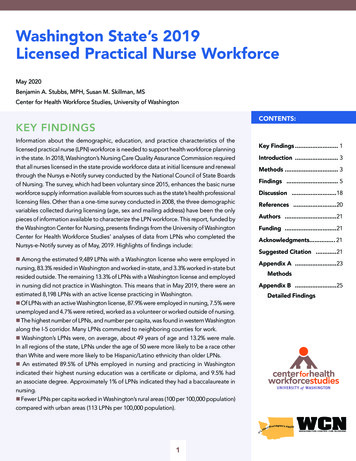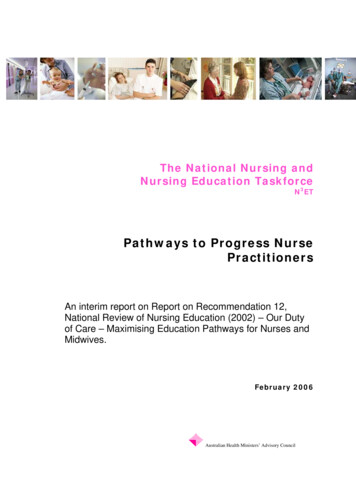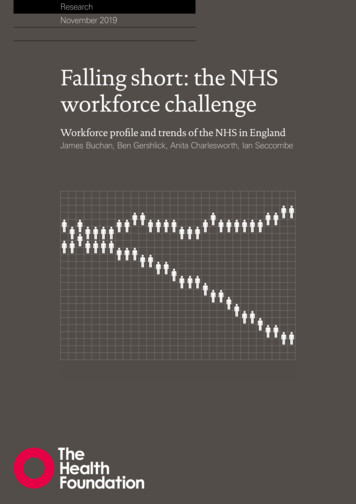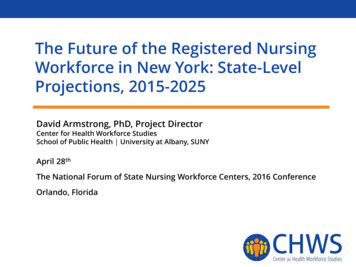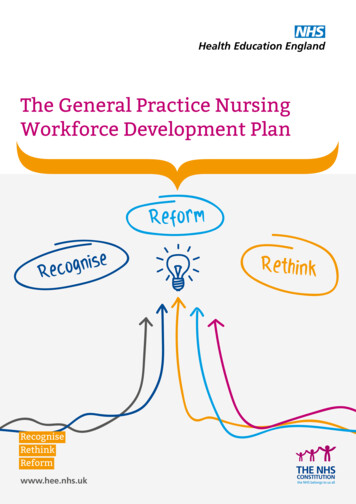
Transcription
Health Education EnglandThe General Practice NursingWorkforce Development hs.ukRethink
Health Education EnglandThe General Practice NursingWorkforce Development PlanContentsThank you from Health Education England . 3Chair’s preface - Dr Peter Lane, FRCGP. 4Executive Summary. 6Summary of Recommendations. 9Section 1: Entry to general practice nursing - pre-registration.12Raising the profile of general practice nursing in schools and colleges.13Raising the profile of general practice nursing in higher education institutions.14Raising the profile of general practice nursing in the public domain.16Placement funding. 16Learning environment quality. 17Section 2: Establishing the role of the general practice nurse - the early years (post-registration).19Availability of careers information for newly-qualified nurses.21Preceptorship.23Mentorship. 24First destination employment – supporting GPs to employ more new nurse graduates.27Induction process.28Promoting clinical academic careers.29Section 3: Enhancing the general practice nursing role - maximising the professionaldevelopment of the workforce.30Embedding the HEE District Nursing and General Practice Nursing Education and Career Framework.32Transitioning into general practice nursing from other fields of nursing practice.32Job descriptions. 35Developing the existing workforce.35The role of GPNs as non-medical prescribers.38Under-utilisation of the Advanced Nurse Practitioner (ANP) role.39Retention. 41Return to practice. 42Supervision, support and governance. 43Leadership. 44Encouraging general practice nursing leadership in communities. 46Section 4: Expanding the healthcare support workforce.47Understanding the healthcare support workforce.48Raising the profile of the HCA in schools and colleges and the public domain.49Apprenticeships.50Learning environment quality. 53Opportunities for role development.54Best practice examples. 55Section 5: A support tool for implementation. 56Conclusion. 57Recommendations with organisations. 58Glossary. 63Acknowledgements. 66Notes and references.672Health Education EnglandThe General Practice NursingWorkforce Development PlanThank you from HealthEducation EnglandOn behalf of Health Education England, we wouldlike to extend our thanks to Dr Peter Lane, thetask and finish group members and everyone whocontributed to this plan. We have been aware ofthe huge amount of dedicated work, research andconsultation that our task and finish group haveundertaken. It was made possible thanks to localand national organisations, general practices andhealthcare professionals who responded honestlywith great enthusiasm and a real desire to bringabout change.For so long we have become used to reports,comments and analysis about workforce pressuresin general practice but its only recently thatattention has been drawn to the increasingpressures in the general practice nursingworkforce.Now is the time for joined up thinking, positivesupport and collaboration from stakeholders fromnational teams to individual practices, to workthrough the current challenges. In practical termswe are beginning to see the development oflocal initiatives such as training hubs that enablenurses to develop their skills in specialist areas andprogress their careers within general practice.Please take the time to look at therecommendations that have come out of thisreview. It has been written in response to ourcommitment to develop a plan specifically forgeneral practice nursing following the House ofCommons Health Committee report into PrimaryCare published in April 2016. It’s our collectiveresponsibility to push forward and it gives us greatpleasure to present this general practice nursingworkforce development plan.Professor Lisa Bayliss-Pratt andProfessor Simon Gregory3
Health Education EnglandThe General Practice NursingWorkforce Development PlanHealth Education EnglandThe General Practice NursingWorkforce Development PlanChair’s Preface - Dr Peter Lane, FRCGPIn an environment awash with strategicdocuments, frameworks, guides, roadmaps andpathways, why do we need a workforce planfor general practice nursing and the healthcaresupport workforce? Unless we keep generalpractice nursing at the centre of our workforcereconfigurations we will simply not develop robustenough teams with the necessary skills to bridgethe increasing gap between capacity and demandbrought on by an ageing workforce, lack of newentrants and increasing workloads.I am a GP and employ a general practice nursingteam so I have first-hand experience of developinginitiatives to tackle nursing shortages. By 2020, it isestimated that many more General Practice Nurses(GPNs) are expected to have retired1. If generalpractice manages the vast majority of NHS patientcontacts2, with more than 340 million consultationsin a general practice setting every year (2013figures)3. Can we afford not to take action?There are nearly 8,000 general practices inEngland. Most are independent businesses withresponsibility for recruiting and developing theirown employees. We hope this document willoffer clear guidance on how we better increaseconsistency in recruitment, retention and return topractice for the general practice nursing family.When Health Education England (HEE) asked meto chair a group of experts to produce a documentthat addressed general practice nursing workforceissues, I knew there was a chance to help promoteand accelerate the change we so urgently need.4This document aims to, recognise, rethink andreform themes, to bring together work withinHEE, NHS England and other key organisations.It outlines the problems, identifies solutionsand makes recommendations. Following this,HEE recommends the development of a ‘howto’ toolkit - something GPs themselves haverequested. We recognise there is a need forsomething that is functional, practical, easy tonavigate and offers resources and guidancewhich is relevant to all stakeholders and groupsinvolved in the implementation and delivery of ourrecommendations.Never has there been a more pressing time foraction. Our document responds to the call toaction of the Five Year Forward View4 to promotehealth and wellbeing, care and quality, fundingand efficiency. It specifically addresses the GeneralPractice Forward View5 pledge of:“A general practice nursing strategy, with an extraminimum 15 million national investment includingimproving training capacity in general practice,increases in the number of pre-registrationplacements, measures to improve retention of theexisting workforce and support for return to workschemes for practice nurses”In May 2016 Professor Jane Cummings, ChiefNurse for England, launched the Leading ChangeAdding Value6 framework for nursing, midwiferyand care staff. We think there is a real opportunityfor GPNs to use their leadership to influence andchampion improvement.Our document gives examples of where we arealready changing the way we do things andaims to support the development of coherentachievable workforce solutions for Sustainabilityand Transformation Plans (STPs) across the country.We need to make general practice nursing a topcareer destination and a shining example of howto respond to the population’s health needs in the21st century.My thanks go to everyone who has workedso hard in pulling this general practice nursingdevelopment plan together. Health EducationEngland, NHS England, the Queen’s NursingInstitute (QNI), the Royal College of GeneralPractitioners (RCGP), the Royal College of Nursing(RCN) with the many contributions, discussionsand suggestions along the way.5
Health Education EnglandThe General Practice NursingWorkforce Development PlanHealth Education EnglandThe General Practice NursingWorkforce Development PlanExecutive SummaryThe highly-skilled general practice nursingworkforce of today provides an essential highstandard of care to their local populations. Theyhave earned their place as both valued andvaluable members of primary care teams. Thegeneral practice nursing team as described in theHEE District Nurse and General Practice NursingEducation and Career Framework7, includeshealthcare assistants (HCAs) at levels 1-4, GPNsat levels 5-6, senior GPNs at level 7 and advancednurse practitioners at level 8. GPNs have becomeclinical leaders in their own right, managing theirown caseloads particularly in the engine room ofincreasingly complex multi-morbidity management,including extended autonomous roles that aredifficult to replace. They offer a large amountof both first contact and continuing care forthe population, managing long-term conditionslike chronic heart disease, diabetes and asthma;treating acute illness and supporting vulnerablegroups like children, the elderly and those withmental health problems, learning disabilities ordementia. They strive to keep them healthy, safeand wherever possible out of hospital. They are theambassadors of health promotion and supportingpatients in self-management. The healthcaresupport workforce is being increasingly recognisedfor their growing contribution in general practiceby supporting GPNs and taking on broader clinicalroles with the potential for further development.The last 30 years has seen a huge change in therole of GPNs and HCAs in a general practicesetting. We now have a combined GPN, AdvancedNurse Practitioner (ANP) and GP healthcaresupport workforce of over 30,0008 (headcount)working in general practice in England. Today’sageing population and the increasing prevalenceof multiple comorbidities, combined with thedrive to shift patient care from hospitals to thecommunity, have prompted moves to expand therole of GPNs and HCAs in primary care. While itmakes sense to bring services closer to patients,there have been few coherent strategies forincreasing this workforce at scale. As existingexperienced GPNs increasingly retire, GPs arestruggling to fill the vacancies with nurses ofsimilar experience. Furthermore, growing financialpressures have reduced GPs’ capacity to grow theirclinical and administrative staff workforce and thishas affected their ability to keep pace with thegrowth in patient demand. The majority of GPNscurrently in post joined general practice from otherhospital and community posts, embarking on a“second career” often with only ad-hoc in-houseorientation and training. This does not comparefavourably with the nurse career structure offeredby larger organisations. Furthermore, generalpractice nursing has rarely been marketed as afirst destination career. Evidence suggests generalpractice is seen to be a “risky choice” for a newlyqualified nurse9.This report is a positive call to action with clearand unambiguous recommendations to improvethe recruitment, retention and return of generalpractice nurses. This directly responds to boththe current and anticipated workforce challengesand acknowledges the need for timely successionplanning and organisational development. Withthis in place it will be possible to replace at scalethe large current cohort of GPNs approachingretirement10 who will take with them their expertknowledge, experience and skills, especially asthe experts in chronic disease management.This in turn will help surgeries flourish not onlymaintaining but improving the quality, range andsustainability of service provision our patientsexpect and deserve. It will also serve to reduceunwarranted variation in service provision.To achieve the goal of right person, right place,right time with greater capacity in general practicesignificant growth of the healthcare supportworkforce at all levels is required. There are greatopportunities now to embrace and develop at pacehealthcare support careers to ensure the wholeclinical team functions to its maximum.6The Primary Care Workforce Commission11suggested methods to enhance general practicenursing recruitment including better managementand the development of leadership skills with clearcareer progression opportunities. Reliable, up-todate careers information is needed. Identifyingexisting and required competencies and howstaff can develop their skills to progress withinan organisation is an important first step to avoidthem seeking career aspirations outside primarycare. In the case of general practice nursing, theHEE District Nurse and General Practice NursingEducation and Career Framework12, RCGP GeneralPractice Foundation, General Practice NurseCompetencies13, RCGP General Practice FoundationAdvanced Nurse Practitioner Competencies14 andRoyal College of General Practitioners HealthcareAssistants (General Practice) CompetencyFramework15 provide this, outlining the skills andeducation required at each level of general practicenursing. It helps staff not only understand whatis expected of them at any point along the careerpathway, but also encourages the aspiring nursewith development opportunities and informs careerprogression programmes.This workforce plan covers four main areas: Entry into general practice nursing (preregistration) – how we improve the visibility andraise the profile of general practice nursing asa first career choice, and in particular increasethe number of training placements in generalpractice for pre-registration nursing students. Establishing the role of the general practicenurse - the early years (post-registration) - howto ensure suitable training and practice supportfor all new entrants to GP nursing to produceeffective GPNs with the appropriate attitudesand skills. Enhancing the GPN role – how to maximisethe professional development of GPNs throughaccessible, fit-for-purpose training and clearlydefined career progression making GPN careersattractive at all levels7
Health Education EnglandThe General Practice NursingWorkforce Development Plan Expanding the healthcare support workforce –how to increase the popularity of the healthcareassistant role, grow numbers at pace whileensuring high-quality, standardised, accessibletraining that leads to appropriate careerpathways.Many of our recommendations are not difficultto achieve and we recognise that many of ourrecommendations may already be happening insome areas, for example, raising awareness ofgeneral practice nursing. Others will require moretime, effort and collaboration working acrossorganisational boundaries, for example, to increasethe number of new entrants and mentors. Careerprogression and development for GPNs mustbe improved. We also need to offer supportedtraining opportunities for the healthcare supportworkforce to further develop their clinical skillbase. While new roles to general practice e.g.physician associates, clinical pharmacists, GP/medical assistants, care navigators and nursingassociates will certainly be able to support generalpractice in the future, delivery at scale will taketime. The HCA role already has clear competenciesset out in the Royal College of General Practitioners(2015) Healthcare Assistants (General Practice)Competency Framework16 and the HEE DistrictNursing and General Practice Nursing Educationand Career Framework17 .Much of the responsibility for tackling the problemslies with individual general practices, GP federationsand the emerging new care models includingmulti-specialty community providers as the leademployers. However, Clinical Commissioning Groups(CCGs) and the emerging HEE national traininghub network, known in some areas as CommunityEducational Provider Networks (CEPNs) or AdvancedTraining Practices (ATPs), will have a crucial partto play. Training hubs are being developed by HEEas part of the General Practice Forward View18 toencourage local expertise and educational supportto help general practice respond to the challenges.We would also call on those delivering the newSTPs to take account of how they can support theseefforts. With their remit to ensure health servicesmeet the needs of local populations, it is importantthat they acknowledge and support the generalpractice nursing workforce initiatives we set out inthis document.The making, shaping and supporting of effectivelocal general practice workforces as a top priorityand an achievable goal across the country will becritical in addressing the unwarranted variations incare and outcomes we currently see.Summary of RecommendationsSection 1Recommendation 1: Raise the profile of general practice nursing careers.A nationally co-ordinated campaign to increase the understanding of the value given to the generalpractice nursing role across all healthcare organisations, schools, colleges and the general public.Recommendation 2: Increase the number of pre-registration nurse clinical placements in generalpractice.Recommendation 3: Introduce quality assurance of the learning environment in general practicefor pre-registration nurses. The HEE Quality Framework and regulatory processes must be adoptedacross England.Section 2Recommendation 4: Increase the uptake of general practice nursing as first destinationemployment for newly-qualified nurses. Review and develop recruitment schemes and supportmechanisms to specifically attract newly-qualified nurses into general practice.Recommendation 5: All new entrant nurses and support staff to general practice have accessto an approved employer-led induction programme. This must be tailored to meet local need,accompanied by a personalised continuing professional development (CPD) plan.Recommendation 6: All new nurses to general practice must receive a standardised andaccredited competency based preceptorship programme to equip them for their general practicenursing role.Such preceptorship programmes should reflect the HEE Preceptorships Standards and the HEEPreceptorship Outcomes Framework and be mapped to the Royal College of General PractitionersGeneral Practice Foundation, RCN (2012 updated 2015) General Practice Nurse Competenciesand the NMC Code.Recommendation 7: GPN educator roles should be developed to cover all CCG areas. Their roleshould include promoting mentor training for all GPNs including sign off mentor roles.Joint higher education and primary care initiatives to further develop mentorship programmesand include registration on local mentor registers. This is critical to growing the capacity of nurseeducation in a general practice setting.89
Section 3Section 4Recommendation 8: All GPNs should have access to accredited training to equip them foreach level of their role. Training should be aligned with the RCGP General Practice Foundation,General Practice Nurse Competencies, HEE District Nursing & General Practice NursingServices Education & Career Framework (2015), supported by the HEE National EducationCommissioning Specification and the QNI/QNIS Voluntary Standards for General Practice NurseEducation and Practice.Recommendation 14: Increase the number of HCAs in general practice to include wideningparticipation schemes that encourage use of the HCA apprenticeship route and support theemerging role of the nursing associate.GP leaders and commissioners should work with HEE to achieve a coalition of support for HEEtaking on this role with appropriate resourcing.Recommendation 16: All education and training for HCAs in general practice must bealigned to the Royal College of General Pra
21st century. My thanks go to everyone who has worked so hard in pulling this general practice nursing development plan together. Health Education England, NHS England, the Queen's Nursing Institute (QNI), the Royal College of General Practitioners (RCGP), the Royal College of Nursing (RCN) with the many contributions, discussions




